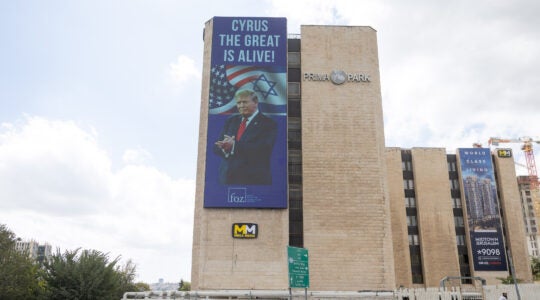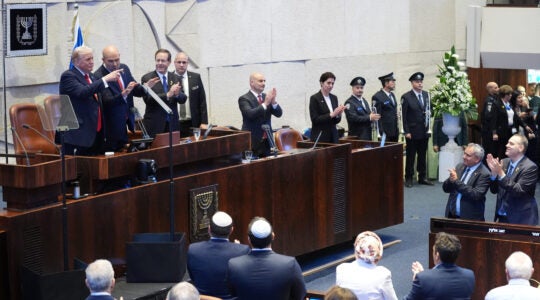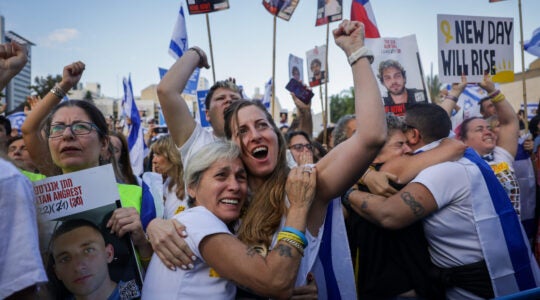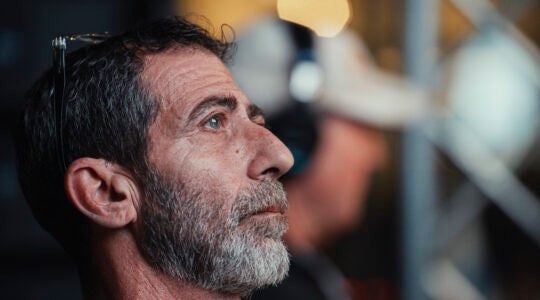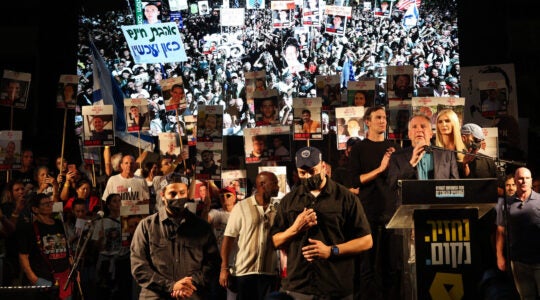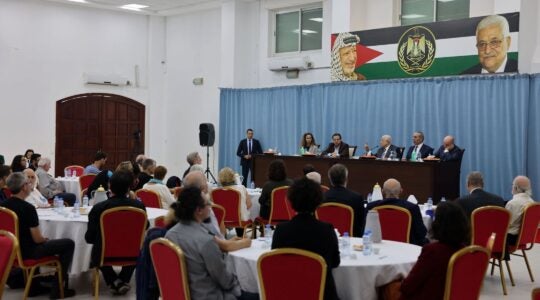JERUSALEM (JTA) – I will never forget my first day in Israel, when a group of teenagers pointed at my tallit and laughed. It was the summer of 1970, and at age 15, I had realized my dream of volunteering on a kibbutz.
Raised in an American home in which Conservative Judaism melded effortlessly with moderate Zionism, I never suspected that some Israelis would see contradictions between the two or that someday I might be forced to choose between them. Instead, I believed that Israel represented the fulfillment of both my national and religious identities. Desperate for that completion, I mowed lawns and shoveled snow to pay for the privilege of working in Israel for free.
But no sooner had I arrived at Gan Shmuel, a diehard Marxist kibbutz, than my illusions of wholeness unwound. Seeing that my suitcase contained a tallit bag, several young kibbutzniks broke out laughing.
Incredulously I asked them, “Aren’t you Jewish?” To which they replied, “Ma pit’om,” – of course not. “We are Israeli.”
The assertion that one could be an Israeli Jew and yet deny one’s Jewishness was utterly unintelligible to my American Jewish mind. Yet many of Israel’s founders cherished the goal of fostering an Israeli identity distinct from Judaism. Socialist Zionist thinkers such as Ber Borochov and Micah Joseph Berdichevski regarded Judaism as the guarantor of Jewish continuity during 2,000 years of exile, one that was easily discarded once the Jews had regained their ancestral homeland.
In place of the mitzvot and rituals, these “secular messianists” advocated a “religion of labor” that promised redemption through working the soil.
“The Jewish national home must be created exclusively through our own work,” declared David Ben-Gurion, “the product of Hebrew labor.”
For some radical Zionists – ironically many of them were associated with the right – even the re-establishment of a Hebrew nation was merely a stage in the re-emergence of a secular society in which Jews and Arabs united as “Canaanites.” Whether right wing or left, most of the early Zionist theorists came from strict Orthodox backgrounds. They knew the Bible, often by heart, and were fully conversant with the tradition they rejected.
Israelis watching Ephraim Kishon’s 1956 play “Black on White” understood that its central joke – the inability of some Jews to pronounce the word “shibboleth” – was a reference to Judges 12:6. As late as 1967, Israeli teens were rocking to hit songs by HaChalonot HaGvoim (The High Windows), Israel’s hottest band, about the coolness of the prophet Ezekiel (“his eyes are like the stones of Tarshish”) and the sad absence of “Abraham our father” and “Moses our teacher.”
Yet the further Israelis strayed from the traditions abandoned by their grandfathers, the closer they moved to a national identity shorn of religious content. The Hebrew nation of which Ben-Gurion and many Zionist founders dreamed had indeed crystallized, but without durable roots in the Jewish spiritual past. Less than two decades after its establishment, the Jewish state found itself in a crisis of identity, floundering between a Jewishness disdained by much of its populace and an Israeliness that few fully understood.
Israelis nevertheless managed to avoid confronting this dilemma until 1967 and the outbreak of the Six-Day War. The sudden reunification of the State of Israel with the Land of Israel transformed a country centered on the post-biblical cities of Haifa and Tel Aviv to one focused on the sacred sites of Hebron and Jerusalem – from a largely Israeli state into an increasingly Jewish state. That dynamic process provided a fillip to the relatively small and formerly low-profile religious Zionists, those who abjured any contradiction between their Jewish and Israeli identity and believed both were integrally linked.
Gush Emunim, or the Bloc of the Faithful, that spearheaded the settler effort appropriated many of the precepts of the old secular pioneers, above all the commitment to inhabit and defend the land. But the insularity and elitism of that movement, to say nothing of its support for a morally nebulous occupation, alienated it from a large segment of secular Israel.
Along with the fervently Orthodox, who rejected the state entirely and refused to serve in its army, the ultranationalist settlers failed to furnish these Israelis with a model of an open, broadly based Zionist and Jewish identity worthy of emulation.
The rift in Israeli identity deepened during the Oslo years, from 1993 to 2000, when secular Israel resolved to forfeit much of the land deemed holy by national religious Israelis. Desperate to prevent this, radical elements assassinated the prime minister. Yet the murder of Yitzhak Rabin failed to halt the peace process, and it was only suicide bombings, not an attachment to the land, that persuaded most Israelis that the process was futile.
Even that realization could not bridge the rift, as demonstrated in the disengagement from Gaza in 2005. For the first time, the State of Israel evicted Jews from an area they regarded as the Land of Israel, creating a chasm that has never completely been bridged. Some of the evacuees even repudiated the covenant between Judaism and the Jewish state, reviling Israel as the impediment to redemption rather than its catalyst.
Reconciling Israel’s twin identities as a secular and Jewish state would be sufficiently difficult if that state were religiously homogenous, which it emphatically is not. Roughly one-fifth of the country’s population – one-fourth under the age of 19 – are Arabs, most of them Muslims, many of whom want to transform Israel into a binational “state of all of its citizens” or replace it with an Islamic caliphate. There are also hundreds of thousands of Druze, Circassians, and Russian Orthodox Christians who, though generally patriotic and willing to serve in the army, have no desire to convert.
Tellingly, the Israel Defense Forces today provides a Hebrew translation of the New Testament for the swearing-in of Christian recruits. The Jews who fight alongside these soldiers are apt to feel closer to them than to anybody in the Diaspora because they are all, manifestly, Israeli.
There is indeed today an Israeli nation – a fact that is widely overlooked both by Israel’s supporters and detractors abroad. But that nation, in spite of a robust communality of language, experience and culture, remains in large part spiritually deracinated. At a recent performance of “Black on White” at my son’s public high school in Jerusalem, not a single student understood the play’s biblical allusions.
A more disturbing display of ignorance occurred at a Shabbat dinner my wife and I attended in Tel Aviv, where candlelighting and prayers were followed by a sumptuous main course – of pork chops. Our sabra host could not even fathom why we were not eating.
Religious anomie and polarization are rife in Israel, yet the state is poised for historic change. In secular betei midrash and in programs for instilling Jewish values in Israeli officers, nonreligious Israelis are reclaiming Judaism from the fervently Orthodox and ultranationalistic monopoly and rediscovering their Jewish roots. The post-army encounter of many young Israelis with the spirituality of India and the Far East has spurred them to explore their own heritage at home. One only has to listen to the innovative music of Shotei Hanevua (The Fools of Prophecy) inspired by the Zohar or the biblically influenced lyrics of the incomparable Banai singers (Ehud, Meir and Eviatar) to know that Judaism again is a source for Israeli creativity.
Much is still to be done, however. Serious efforts must be mounted to loosen the Chief Rabbinate’s stranglehold over personal affairs – marriage, divorce and burial – to rid the kashrut system of corruption and reform the conversion process. Major resources must be invested in facilitating dialogue between Israeli Jews from various religious backgrounds as well as between Israeli and Diaspora youth. The Taglit-Birthright Israel program that has strengthened Jewish identity worldwide by bringing nearly 160,000 young Jews to Israel should be expanded to enable Israelis to experience different forms of Jewish spirituality in America and elsewhere. National priority must be given to convincing all of Israel’s citizens that the state can be made more Jewish without rendering it less Israeli.
In its 60 years of existence, Israel has succeeded in surmounting immeasurable obstacles and galvanizing a nation. But it still faces the most formidable challenge: welding its identities as an Israeli and a Jewish state. The goal is to create an Israel where young kibbutzniks watching a newly arrived American Jew unpack his tallit will not laugh but rather remark, “sababa” – cool. “Want to see ours?”
(Michael Oren is the author most recently of “Power, Faith, and Fantasy: America in the Middle East, 1776 to the Present.”)
JTA has documented Jewish history in real-time for over a century. Keep our journalism strong by joining us in supporting independent, award-winning reporting.
